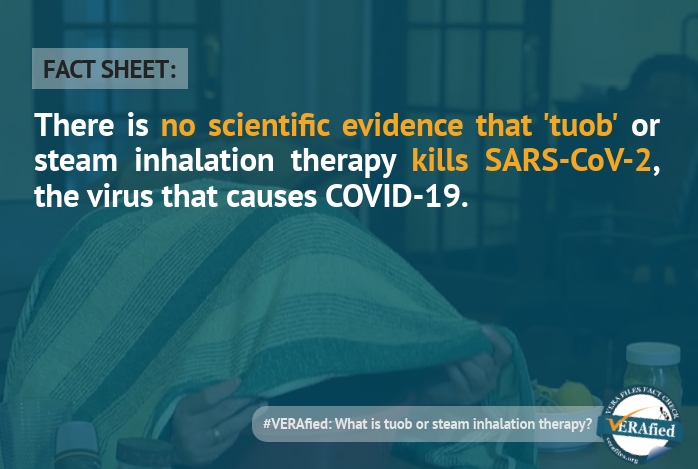Editor’s Note: This fact check was published in July 2020, early on during the COVID-19 pandemic. The WHO’s statement “While some western, traditional, or home remedies may provide comfort and alleviate symptoms of mild COVID-19, there are no medicines that have been shown to prevent or cure the disease” was true at the time.
However, there are now vaccines proven to be able to prevent COVID-19, as well as medicine and health practices to treat the disease. Steam inhalation or tu-ob may help with relieving COVID-19 symptoms.
Cebu Governor Gwendolyn Garcia earned the ire of netizens and health experts for publicly shaming doctors who criticized a local memorandum urging provincial officials and employees to perform “tuob” or steam inhalation as means to help contain the coronavirus disease (COVID-19).
In Memorandum No. 36-2020, signed on June 18 by Provincial Administrator Noli Vincent Valencia, department heads and employees were “enjoined” to have hot steam inhalation twice a day, between 8 and 9 a.m. and 4 and 5 p.m., at their work stations.
This is in line with Executive Order No. 17 or general community quarantine guidelines the Cebu governor issued in May, which includes tuob as part of a “health regimen” to boost the immune system in combating COVID-19.
Garcia, who lashed out at doctors for at least an hour during her June 23 online presser, claimed that the COVID-19 virus “does not survive beyond 27 degrees Celsius.” She added that when one inhales hot steam and it reaches the respiratory tract, “it will melt the fat surrounding the virus, thus killing it.”
To lend credibility to her “wellness” directive, Garcia previewed a video testimonial of Interior Secretary Eduardo Año, who said he practiced tuob when he tested positive for COVID in late March and felt better after. He said Education Secretary Leonor Briones did the same.
What is tuob or steam inhalation? Does it cure or prevent COVID-19?
Here are three things you need to know:
1. What is steam inhalation therapy?
Steam therapy entails wrapping one’s head in a towel or any thick cloth with a basin or pot of steaming water with salt or mixture of herbs underneath to make one sweat while inhaling the vapor for five to 10 minutes, according to health information site Healthline.
Commonly practiced as a home-based therapy, steam inhalation helps loosen the mucus secretions, clearing up nasal and respiratory passages — relieving symptoms of common colds and dry cough.
A “stuffy” or congested nose “occurs when the tissues lining it become swollen” due to “inflamed blood vessels,” according to the U.S. online medical encyclopedia.
At least two Filipino studies published in 2015 and 2016 in different scientific journals showed that “tuob” (suob in Tagalog) or boiling ritual has been used by traditional healers accompanied by other healing methods, such as “hilot” or massage therapy.
2. Can it be used to cure or prevent COVID-19?
Health Undersecretary Maria Rosario Vergeire said in a June 25 virtual presser that there is “no scientific evidence that steam inhalation kills the SARS-CoV-2 (the virus causing COVID-19).”
“While some western, traditional, or home remedies may provide comfort and alleviate symptoms of mild COVID-19, there are no medicines that have been shown to prevent or cure the disease,” the World Health Organization said in its Q&A; on coronaviruses (COVID-19).
The Philippine Medical Association (PMA), an umbrella organization of physicians in the country, denounced Garcia for her “dangerous claims and insults” to medical members who disagreed with her advocacy for tuob.
In a three-page statement issued on June 24, PMA said the Cebu governor’s claim may “foster a false sense of security and well being,” and may facilitate transmission of the virus by aerosols and contamination of nearby persons, objects, or surfaces.
Likewise, WHO said it “does not recommend self medication with any medicines, including antibiotics, as prevention or cure for COVID-19.”
It added that exposure to high temperatures will not prevent a person from getting the disease.
When one still wants to proceed with the steam therapy, it should be done with caution, Vergeire said. Should COVID-19 symptoms persist, one should immediately seek medical help, she added.
WHO Representative in the Philippines Rabindra Abeyasinghe, in an earlier interview with VERA Files, also reiterated that water steam mixed with other concoctions such as salt “will not prevent you from catching COVID-19.” (See VERA FILES FACT CHECK: Salt water steam DOES NOT kill coronavirus and VERA FILES FACT CHECK: FB posts claiming 2019-nCoV only survives in ‘cold weather,’ salabat a cure NOT TRUE )
The only clear indication if someone already recovered from COVID-19 is through a series of negative testing results. (See VERA FILES FACT SHEET: Five things you need to know about COVID-19 antibodies and The science behind COVID-19 testing)
3. What are the risks and benefits of steam therapy?
Steam therapy may help alleviate symptoms of colds and sinus blockage of the respiratory tract.
However, it will not eliminate any virus still present in the body, according to a 1994 study published in the United States National Institutes of Health.
Several studies which assessed steam inhalation as treatment, such as a 2016 paper conducted in the United Kingdom, a 2013 research that evaluated six trials in different countries, and a 2013 study also in the U.K., said it has no proven or significant benefit.
WHO, DOH, and PMA are one in reminding the public that extremely hot steam can be harmful as there is risk of burn injury in the respiratory tract and scalds from hot water accidents.
Protecting oneself from COVID-19 through frequent hand washing, social distancing, practicing cough etiquette, and wearing masks still remain the most effective ways to prevent getting the virus.

